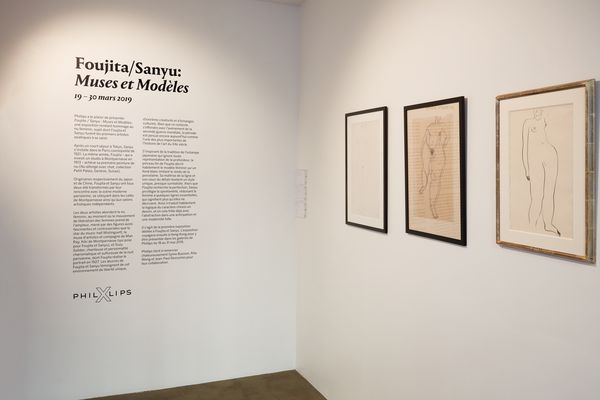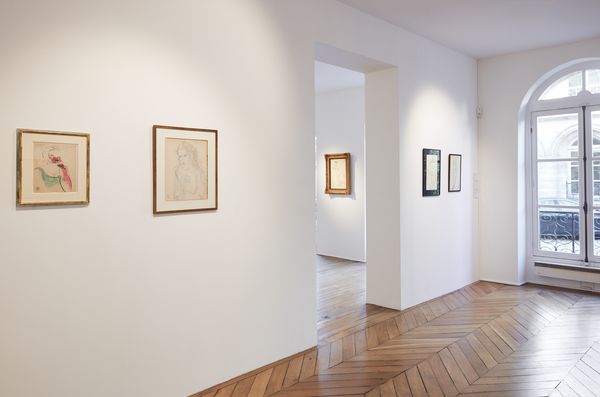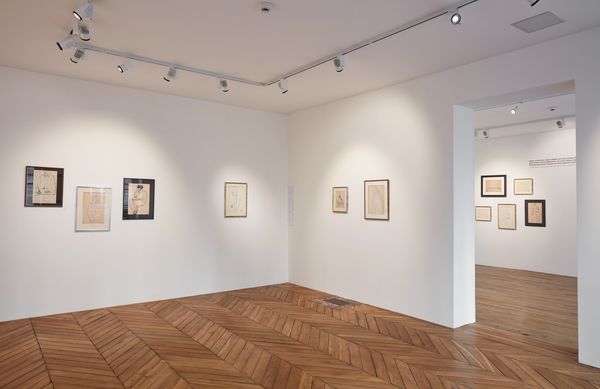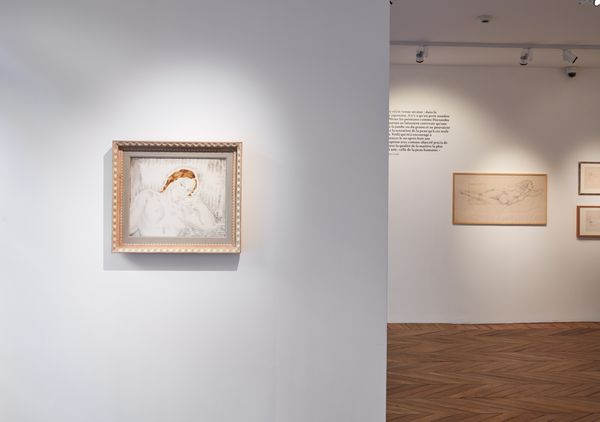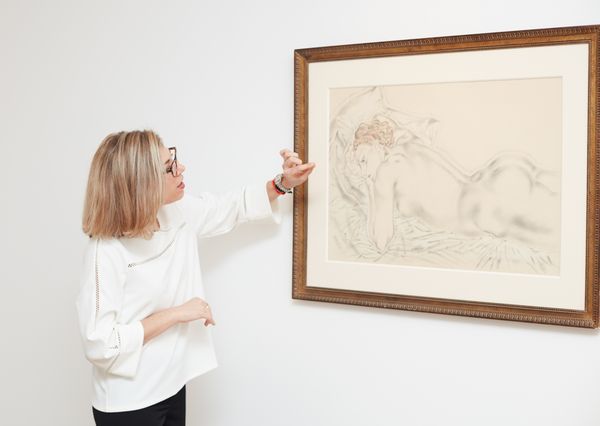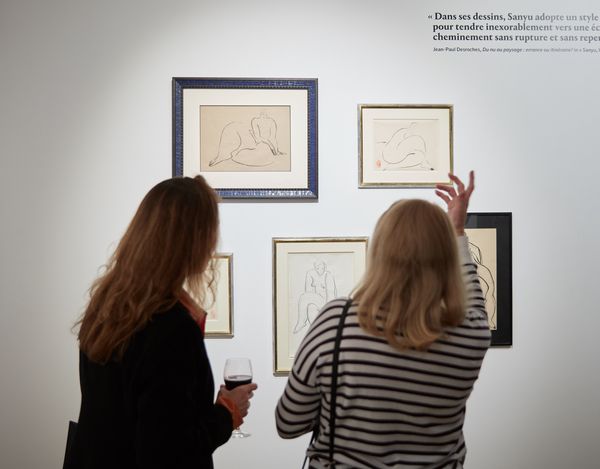Clara Rivollet in the Phillips Paris gallery space
Our latest Phillips X selling exhibition focuses on female nudes by Léonard-Tsuguharu Foujita and Sanyu, two artists who bridged the gap between Asian and European art history. After showing in Paris from 19-30 March, Foujita / Sanyu: Muses and Models will travel to Hong Kong from 18-31 May. This was International Specialist Clara Rivollet's first time curating a selling exhibition at Phillips since joining the company earlier this year. We sat down with Clara to learn more about the driving force behind the show, and how this critical moment in art history came to pass.
PHILLIPS: Can you tell us a little bit about your background and how you came to Phillips?
CLARA RIVOLLET: I was born and raised in Switzerland. Like most of Geneva, I have mixed European origins as my grandparents were from four different countries. After studying French literature and art history in Geneva and Montreal, I quickly moved to Paris where I worked for 6 years at Christie’s, liaising between Europe and sales in Hong Kong and Shanghai. I love that my job combines the adrenaline of auctions and the intellectual stimulation of art. I joined Phillips less than 5 months ago, seduced by the thrill of an adventure in motion and its creative and entrepreneurial spirit. Let me tell you, I have not been disappointed!
P: Outside of Paris, what are some of the cities where you’ve spent much of your time? How do you find that they compare to Paris as arts and cultural centers?
CR: I've lived in Geneva, Montreal, Hong Kong, New York and Tel Aviv, and I am on the road often to meet clients, attend art fairs and visit museum exhibitions. Although I do not have a French passport, I am a hard-core adopted Parisian! While London, Hong Kong and New York are naturally strong art markets, Paris is the city of museum shows, art history and architectural gems. Paris’ place in the art market has recently strengthened with the now-essential additions of FIAC, the high-quality specialized art fair, Paris Photo, “AKAA” (African contemporary art fair) and the affordable art fair, “Galeristes”.
P: Turning to our exhibition now on view at Phillips Paris, Foujita/Sanyu: Muses and Models, how was it that both artists ended up in Paris in the early 20th century?
CR: Paris was the indisputable international capital for the arts, probably the first city with such an international impact in the history of art, at a time of relatively difficult travel and communication. Like most global phenomenons, there is still something mysterious as to how this context came to life. There is something unexplainable in the French culture, politics of the time, and historical factors that magically converged in Paris in the 1920s to create this unique environement of freedom and artistic emulation. But essentially, Paris was just so famous back then that naturally it was a must for foreign artists to visit the city.
Foujita’s and Sanyu’s work has its importance in the convergence of both Asian and Western art history: it is simply universal.
Sanyu benefited from a cultural exchange program in place between France and China. He was the first Chinese person to remain in France, while his famous counterparts Lin Fengmian and Xu Beihong went back to China respectively in 1926 and 1927. Before moving to Paris in 1913, Foujita studied under Kuroda Seiki, the director of the Western painting department at the Tokyo University of the Art, and one of the first Japanese artists to study in Paris in the late 19th Century. While many young Japanese and Chinese artists came to Paris to study and mingle, Foujita and Sanyu clearly stand out as they truly integrated to the Paris scene and added their own voice to Western art history: that’s what we want to show with this exhibition.
P: Is there any evidence that Foujita and Sanyu actually knew each other or interacted during their time in Paris?
CR: While we do not have any formal trace of such an encounter, it is impossible that they did not meet, or at least see each other’s work. Both of their names appear in the list of exhibitors at the Salon d’Automne in 1925. Both artists shared the same Montparnasse with its cafés, crazy nights and small social circles. However, to put all of this back into context: Foujita is already very integrated into Paris by the 1920s, a close friend of Modigliani, Soutine and Picasso, a jury member at the Avant-Garde Salon d’Automne, several gallery solo shows and his work is in State Museums collections. At that time, Sanyu is still a young Chinese artist with no real connections nor great visibility.
P: When did you first have the idea to present these artists together? Was the theme of the female nude something that came later, or was that an integral part of this show from the beginning?
CR: Last year was the Musée Maillol exhibition ‘Foujita peindre dans les années folles’, which made me rediscover the modernity of the artist. At the same time, I was always passionate about Sanyu’s work, and find it unfair that he is still completely unknown to the French public even though the entirety of his creation was done in France. Both artists seize the depiction of woman as a subversive subject matter to push the boundaries further into avant-garde, at a time when strong female characters emerge in the Parisian scene such as Music hall star Mistinguett, singer Suzy Solidor and artists’ muse Kiki de Montparnasse.
As an awakened feminist, I am intrigued and inspired by this time period that strived toward progressivism in a rather uncertain political context. In addition, we are in a moment of reevaluating the narritives of 20th Century Art History, acknowledging the importance of non-Western movements and influences. It is time to restore Sanyu and Foujita’s importance in Western Avant-Garde. There is something converging between the woman and the Asian gaze, an ‘otherness’ which acts as an enriching alternative.
P: How do these works interact with one another? What are some of the main points of contrast between Foujita and Sanyu?
CR: Foujita and Sanyu, respectively from Japanese and Chinese origins, obviously share some Asian art references: the knowledge of calligraphy and core concepts of Asian classical painting, which clearly makes their mastery of the line above their contemporaries. Their line is utterly different, though: Sanyu’s line is spontaneous, elliptic and transforming. Foujita’s is descriptive, controlled and synthetic.
P: How does this exhibition challenge preconceived notions of what counts as “Western” or “Asian” art?
CR: What counts? Where was the artwork created? What references does it convoke? What nationality was its maker? Who is depicted? Who does it appeal to? Foujita’s and Sanyu’s work has its importance in the convergence of both Asian and Western art history: it is simply universal.
P: How will the show change as it moves from Paris to Hong Kong?
CR: In Paris we favored works on paper as the show coincided with the Salon du Dessin (the drawing art fair). I believe the essence of both artists lie within this medium, which has its deepest roots in Asian painting. The idea was also to put the spotlight on French collections. As the show travels to Hong Kong we will exhibit more paintings and favor Asian collections.
P: As a curator, what is your history with these artists? And as this was your first time curating a show for Phillips, were there any unexpected challenges along the way?
CR: I have passionately investigated the ties between Asian artists and France for several years. I previously organized two shows on the subject matter: “Seeing Paris: a Chinese adventure” about the Chinese artists of the Paris school and “Zao Wou-Ki: a calligraphic journey” to show how the artist reinterpreted calligraphy into abstract painting.
At Phillips you have to be very resourceful: being able to negotiate a deal, contact a restorer, apply for an authentication certificate, coordinate a photo shoot, catalogue a work, write an essay, answer a journalist and moderate a panel discussion at the same time. But you really feel in the driver's seat which is terribly exciting! You feel you have a voice.
P: As art collecting and viewing becomes easier and easier to do online, why did you feel it was important for this show to travel to both Paris and Hong Kong?
CR: Online is great to have access to knowledge but it will never replace the pleasure of looking at an artwork in person. Hong Kong is the natural place for an exhibition on these artists but I really made a point of showing it first in Paris in its context of creation and give the French audience the opportunity to discover them first. After all, all the works featured in the exhibition were created just a few streets away from our Paris space situated on 46 rue du Bac.

